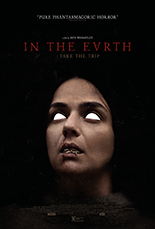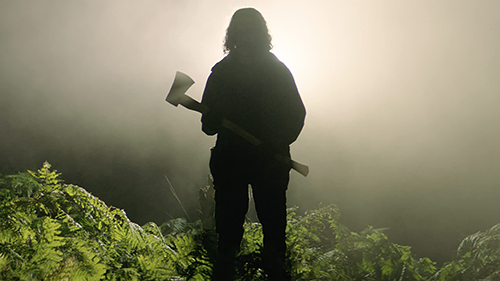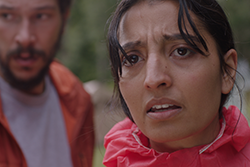
 With movies being a great escape from the grind of daily life, it’s ironic that the global pandemic has kept them off-limits for about a year. Now that we have figured out how to co-exist with the virus — well, some of us, anyway — we can attend an actual theater again!
With movies being a great escape from the grind of daily life, it’s ironic that the global pandemic has kept them off-limits for about a year. Now that we have figured out how to co-exist with the virus — well, some of us, anyway — we can attend an actual theater again!
Among our scant few choices? A film about our very real COVID conundrum: In the Earth. Good thing it’s pretty close to great. Coming from writer/director Ben Wheatley — returning to the folk-horror roots of 2011’s brilliant Kill List, his greatest success in a chameleon of a career — its core message is this: Can’t wait to get back to your old, pre-coronavirus ways? Yeah, that’s not gonna happen.
After a year in lockdown, a remote wilderness lodge reopens to host scientist Martin Lowery (Joel Fry, 10,000 BC) for field research. He’s studying its fertile forest land to develop more efficient crops. As he’s setting up shop, others at the lodge mention a local folktale of a spirit in the woods, talk of mysterious deaths in a nearby village, reports of people lost in the woods, rumors of a professor missing for months — omens Wheatley dispenses to his players as often as hand sanitizer.

When park ranger Alma (Ellora Torchia, Midsommar) guides Martin into the woods to show him the ropes, they encounter Zach (Reece Shearsmith, Wheatley’s High-Rise), a babbling kook who performs rites in an effort to communicate with Mother Nature. An act of violence traps this unlikely triumvirate, forcing Martin and Alma to wonder if even a shred of truth exists in Zach’s freakish theories and activities.
I’m purposely being vague to let In the Earth’s surprises do their dirty work on you, too.
 It gives nothing away to say In the Earth finds a “happy” medium between the ghostly phenomenon of The Stone Tape and the ghastly witchery of Suspiria. Just as those works span varying styles of horror, Wheatley begins his high-strung story with the cheeky innocence of urban legends as campfire tales before invading that purely mental space with the unflinching physicality of modern gore. Will audiences cringe more at a rather pointed instance of ocular trauma or an impromptu amputation and subsequent cauterization? It’s a toss-up, but Lucio Fulci would be proud of the former, while the latter makes Kathy Bates’ famous swing of the sledgehammer look like T-ball practice.
It gives nothing away to say In the Earth finds a “happy” medium between the ghostly phenomenon of The Stone Tape and the ghastly witchery of Suspiria. Just as those works span varying styles of horror, Wheatley begins his high-strung story with the cheeky innocence of urban legends as campfire tales before invading that purely mental space with the unflinching physicality of modern gore. Will audiences cringe more at a rather pointed instance of ocular trauma or an impromptu amputation and subsequent cauterization? It’s a toss-up, but Lucio Fulci would be proud of the former, while the latter makes Kathy Bates’ famous swing of the sledgehammer look like T-ball practice.
As the film expands into ever more disturbing territory, sound becomes a critical factor; as a viewer, you feel the pummeling the characters take. Add strobe lighting, subliminal imagery and X-Acto editing by Wheatley, and you’re no longer watching a movie but experiencing a potentially allergy-triggering exercise in psychedelic immersion. The effect is not unlike my most recent trip to the dentist, when an overdose of nitrous oxide caused my hand to vibrate loudly as it existed in 16 places at once. You had to be there.
Or you can be here, under Wheatley’s divisive spell, which I recommend. Those daring to cross the threshold will emerge 100 minutes later with one of two educated opinions: that In the Earth is either a tool of torture best reserved for war criminals or a generous dose of terrifying, cinematic sensory bliss. Following end titles unlike any I’ve seen before, I left with a headache. I’m serious when I say that’s a plus. —Rod Lott
